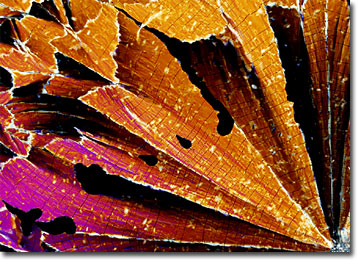Polarized Light Microscopy Digital Image Gallery
Clozaril
Introduced in Europe in 1975 by the Novartis Pharmaceuticals Corporation, clozaril was one of the first new drugs developed to treat schizophrenia in over 20 years. The pharmaceutical, which helps keep hallucinations, delusions, and hostility under control, did not enter the United States market until 14 years later and continues to be most heavily utilized in the Eastern Hemisphere.

Clozaril is a yellow, crystalline powder that is usually imbibed in pill form. The chemical substance, which is very slightly soluble in water, primarily functions within the body by binding to dopamine receptors in the limbic system of the brain. Thus, the drug helps regulate dopamine action, which is centrally involved in the perception of reality, feelings, and moods. Clozaril also is an antagonist to other binding sites in the central nervous system, including the adrenergic (weight gain, moodiness, arousal, startle response), cholinergic (memory), histaminergic (sleep and weight gain), and serotonergic (depression, anxiety, panic, aggression) receptors. Through such biochemical means, the drug is able to help reduce the characteristic symptoms of schizophrenia, but cannot cure the typically genetic disorder.
There is a certain amount of hesitation in the medical field to prescribe clozaril to any but the most severe sufferers of schizophrenia. This reluctance is due to the serious side effects associated with the drug, which include seizures, decreased blood pressure, accelerated heart rate, myocarditis, and agranulocytosis, or a dangerously reduced white blood cell count. Moreover, a number of more standard drug therapies are often utilized before clozaril is recommended in hopes that treatment with the antipsychotic medication will not be necessary. On the positive side, however, clozaril is not believed to be addictive, nor does the drug generate a "high" for the patient. As with any medications, prospective patients and their guardians should consult with their medical practitioner before beginning clozaril therapy in order to fully understand all of the potential risks and benefits of treatment.
